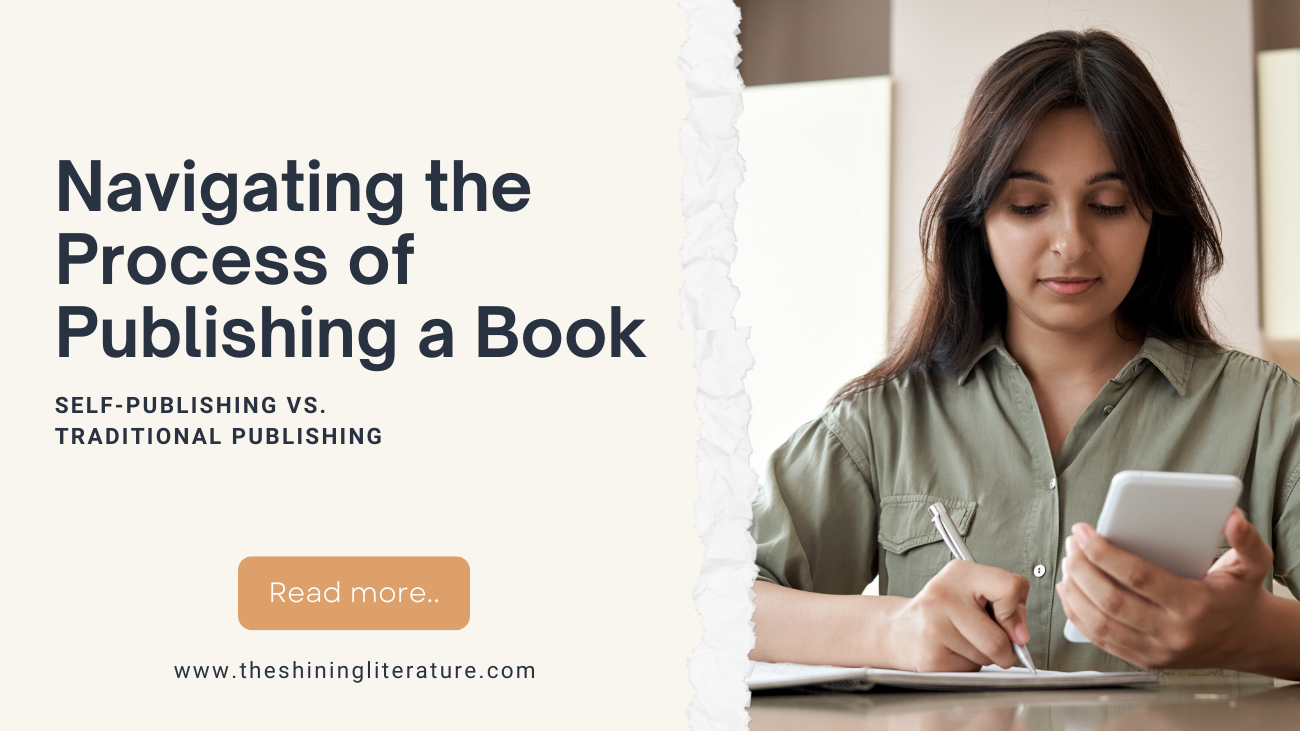Navigating Navigating the Process of Publishing a Book: Self-Publishing vs. Traditional Publishing
The “process of publishing a book” is an intricate journey filled with passion, dedication, and numerous decisions. Whether you choose to embark on the path of self-publishing or opt for the more conventional route of traditional publishing, understanding the steps involved is crucial. In this article, we will explore the intricate “process of publishing a book,” shedding light on both self-publishing and traditional publishing methods.
Part 1: Traditional Publishing
Traditional publishing has been the hallmark of the publishing industry for centuries. This “process of publishing a book” involves a collaboration between an author and a publishing house. Here are the essential steps involved:
Writing and Editing:
The journey begins with an author writing a manuscript. Once the manuscript is complete, it undergoes thorough editing to ensure the highest possible quality.
Querying Literary Agents or Publishers:
Authors usually seek representation by querying literary agents or submitting their manuscript directly to publishing houses. Literary agents act as intermediaries, connecting authors with the right publishers in the “process of publishing a book.”
Acquisition:
Once a literary agent or publisher expresses interest, the manuscript goes through a vetting process. If accepted, the author typically receives an advance against future royalties in the “process of publishing a book.”
Editing and Revisions:
After securing a deal, the manuscript undergoes additional rounds of editing and revisions under the guidance of the publisher’s team, a critical phase in the “process of publishing a book.”
Design and Production:
Publishers handle the book’s cover design, interior layout, and printing. This “process of publishing a book” ensures the book’s professional appearance.
Distribution and Marketing:
Traditional publishers have an established distribution network, making it easier to get books into physical stores and online retailers. Marketing campaigns are also typically provided as part of the “process of publishing a book.”
Release:
The book is finally released to the public, with the hope of reaching a wide readership as the final step in the “process of publishing a book.”
Royalties:
Authors receive royalties based on the sales of their books, but these are subject to the advance already paid as part of the “process of publishing a book.”
Part 2: Self-Publishing
Self-publishing has gained immense popularity in recent years, empowering authors to take control of their work. Here are the steps involved in self-publishing in the “process of publishing a book”:
Writing and Editing:
Like traditional publishing, self-publishing starts with writing and thorough editing of the manuscript in the “process of publishing a book.”
Cover Design and Formatting:
Authors can hire professionals or use self-publishing platforms to design the book cover and format the interior, vital elements in the “process of publishing a book.”
ISBN and Copyright:
Authors should obtain an International Standard Book Number (ISBN) and register the copyright for their book, safeguarding their intellectual property in the “process of publishing a book.”
Publishing Platforms:
Authors can choose from various self-publishing platforms, such as Amazon Kindle Direct Publishing (KDP), Apple iBooks, or IngramSpark, to publish their book in the “process of publishing a book.”
Also read: Top Book Publishing Platforms in India 2024
Distribution:
Self-publishing platforms often have global distribution networks, making it easier to reach readers worldwide during the “process of publishing a book.”
Marketing:
Self-published authors are responsible for marketing their books, a critical aspect of the “process of publishing a book.” This involves building an author platform, promoting through social media, and potentially investing in advertising.
Sales and Royalties:
Authors set their book’s price and receive a higher percentage of royalties compared to traditional publishing. Income is earned directly from book sales, making the financial aspect of the “process of publishing a book” more rewarding for self-published authors.
Self Publishing Platforms in India
Conclusion
The “process of publishing a book,” whether through traditional or self-publishing methods, demands dedication, patience, and hard work. Traditional publishing offers the benefits of professional support and established distribution channels but involves a lengthy and competitive process. Self-publishing grants authors more control and higher royalties but requires extensive self-promotion and marketing efforts.
Ultimately, the choice between traditional and self-publishing depends on an author’s goals, resources, and preferences. Whichever path you choose, the joy of seeing your words in print and sharing your story with the world is a rewarding experience in the “process of publishing a book.”
Also read: Highest Rated Books in Amazon – Indian Writing 2023




